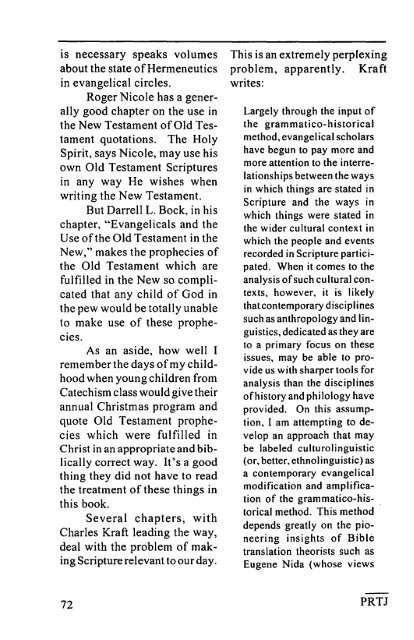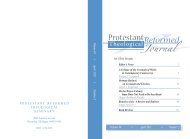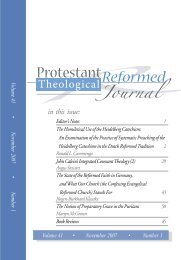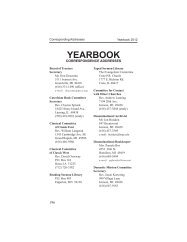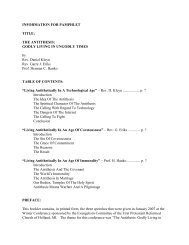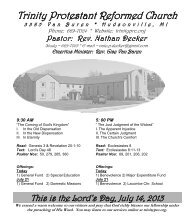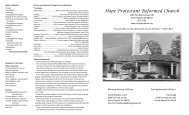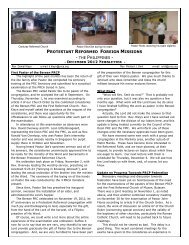Book Reviewsby the work of the Holy Spirit'who illum<strong>in</strong>ates the m<strong>in</strong>d andwitnesses to the veracity ofthediv<strong>in</strong>e verities'" (p. 77).The same chapter emphasizesScripture's clarity, a Reformationpr<strong>in</strong>ciple which impliesthe ability of all God'speople to understand the sacredrecord (pp. 78, 79).In a chapter entitled "Us<strong>in</strong>gand Abus<strong>in</strong>g Language,"Moises Silva warns aga<strong>in</strong>st misus<strong>in</strong>gword studies <strong>in</strong> etymology,synonyms, etc., but carriesthe warn<strong>in</strong>g too far when herelegates many dist<strong>in</strong>ctions <strong>in</strong>Scripture to mere rhetorical devices.Verbal <strong>in</strong>spiration meansthat the Holy Spirit used everyword with a purpose.Several chapters warnaga<strong>in</strong>st mak<strong>in</strong>g the understand<strong>in</strong>gof Scripture difficult by amultitude ofdist<strong>in</strong>ctions, exercises<strong>in</strong> literary analysis, <strong>in</strong>terpret<strong>in</strong>g<strong>in</strong> the light of non-canonicalliterature (such as theJewish Mishnah), and impos<strong>in</strong>gcomplicated literary frameworkson the text. But otherchapters (see, for example, pp.8 & 9) pile dist<strong>in</strong>ction on dist<strong>in</strong>ctionand exercise on exerciseas be<strong>in</strong>g essential to expla<strong>in</strong>the sacred text.Norman Geisler has anexcellent chapter entitled "The'Relation ofPurpose and Mean<strong>in</strong>g<strong>in</strong> Interpret<strong>in</strong>g Scripture."He warns aga<strong>in</strong>st mak<strong>in</strong>g purposedeterm<strong>in</strong>e mean<strong>in</strong>g, ratherthan mean<strong>in</strong>g dete~m<strong>in</strong>e purpose.He po<strong>in</strong>ts out, correctly,that the former leads to a nonliteral<strong>in</strong>terpretation of Scripture,as, e.g., <strong>in</strong> the <strong>in</strong>terpretationof Genesis 1. Those whodeterm<strong>in</strong>e <strong>in</strong> advance that thepurpose of Genesis I isdoxological then proceed todeny its literal mean<strong>in</strong>g. Hepo<strong>in</strong>ts out that the same th<strong>in</strong>ghas been done with texts condemn<strong>in</strong>ghomosexuality, andBultmann's demythologiz<strong>in</strong>gwas the end result of mak<strong>in</strong>gmean<strong>in</strong>g dependent on purpose.It is a chapter every student ofScripture ought to read.WalterJ. Kaiser, Jr. pleads<strong>in</strong> a chapter with the title, "TheS<strong>in</strong>gle Intent of Scripture," forthe position that Scripture hasonly one mean<strong>in</strong>g. That mean<strong>in</strong>gis the obvious one, the oneobvious from the words andthoughts. It is, says Kaiser, the"surface" mean<strong>in</strong>g, the "prosaic"mean<strong>in</strong>g; and it is the correctone. Look<strong>in</strong>g for othermean<strong>in</strong>gs, he warns, reducesexegesis to a shambles. Thevery fact that a warn<strong>in</strong>g like thisNovember, 200 I71
is necessary speaks volumesabout the state ofHermeneutics<strong>in</strong> evangelical circles.Roger Nicole has a generallygood chapter on the use <strong>in</strong>the New Testament ofOld Testamentquotations. The HolySpirit, says Nicole, may use hisown Old Testament Scriptures<strong>in</strong> any way He wishes whenwrit<strong>in</strong>g the New Testament.But Darrell L. Bock, <strong>in</strong> hischapter, "'Evangelicals and theUse ofthe Old Testament <strong>in</strong> theNew," makes the prophecies ofthe Old Testament which arefulfilled <strong>in</strong> the New so complicatedthat any child of God <strong>in</strong>the pew would be totally unableto make use of these prophecies.As an aside, how well Iremember the days ofmy childhoodwhen young children fromCatechism class would give theirannual Christmas program andquote Old Testament prophecieswhich were fulfilled <strong>in</strong>Christ <strong>in</strong> an appropriate and biblicallycorrect way. It's a goodth<strong>in</strong>g they did not have to readthe treatment ofthese th<strong>in</strong>gs <strong>in</strong>this book.Several chapters, withCharles Kraft lead<strong>in</strong>g the way,deal with the problem of mak<strong>in</strong>gScripturerelevant to ourday.This is an extremely perplex<strong>in</strong>gproblem, apparently. Kraftwrites:Largely through the <strong>in</strong>put ofthe grammatico-historicalmethod, evangelical scholarshave begun to pay more andmore attention to the <strong>in</strong>terrelationshipsbetween the ways<strong>in</strong> which th<strong>in</strong>gs are stated <strong>in</strong>Scripture and the ways <strong>in</strong>which th<strong>in</strong>gs were state.d <strong>in</strong>the wider cultural context <strong>in</strong>which the people and eventsrecorded <strong>in</strong> Scripture participated.When it comes to theanalysis ofsuch cultural contexts,however, it is likelythatcontemporary discipl<strong>in</strong>essuch as anthropology and l<strong>in</strong>guistics,dedicated as they areto a primary focus on theseissues, may be able to provideus with sharper tools foranalysis than the discipl<strong>in</strong>esofhistory and philology haveprovided. On this assumption,I am attempt<strong>in</strong>g to developan approach that maybe labeled culturol<strong>in</strong>guistic(or, better. ethnol<strong>in</strong>guistic) asa contemporary evangelicalmodification and amplificationof the grammatico-his- .torical method. This methoddepends greatly on the pioneer<strong>in</strong>g<strong>in</strong>sights of Bibletranslation theorists such asEugene Nida (whose views72PRTJ
- Page 1 and 2:
ProtestantReformedTheologicalJourna
- Page 3 and 4:
EDITOR'S NOTESProf. Russell J. Dyks
- Page 5 and 6:
For there are many, even l unruly,
- Page 7 and 8:
happen to hold unwittingly to some
- Page 9 and 10:
tion oftheir false teachings. II Pe
- Page 11 and 12:
est, they are very weak, at worst,
- Page 13 and 14:
truth~' (see I Tim. 4: 1 - 4). Ever
- Page 15 and 16:
Thomas Bradwardine:Forgotten Mediev
- Page 17 and 18:
ated grace and uncreated grace. Unc
- Page 19 and 20:
Bradwardine faces the question ofth
- Page 21 and 22: the age, namely, that having set fo
- Page 23 and 24: did not identify Thomas Bradwardine
- Page 25 and 26: The first is that Bradwardine was a
- Page 27 and 28: to Bradwardine as oneof"two pre-emi
- Page 29 and 30: Gospels, Acts, and Revelation. Sir
- Page 31 and 32: power of the papacy in Bradwardine'
- Page 33 and 34: The Serious Callof the Gospel -Is t
- Page 35 and 36: elieve th~s proclamation with uprig
- Page 37 and 38: to bring good news with their "fig
- Page 39 and 40: nation, we read of Melchisedek, the
- Page 41 and 42: official activity ofa monarch's her
- Page 43 and 44: 8): "Calling is ofthose elect and r
- Page 45 and 46: ut all his posterity unable to obey
- Page 47 and 48: alone, and He saves whom He will. E
- Page 49 and 50: have moved away from the notion oft
- Page 51 and 52: every member ofthe visible, institu
- Page 53 and 54: fulfilling this calling is their pa
- Page 55 and 56: contingent. Further, Calvin did not
- Page 57 and 58: ofacceptance in terms of merit, ins
- Page 59 and 60: covenant ofgrace and works, or it i
- Page 61 and 62: Spiritual, Suffers Them to DefileTh
- Page 63 and 64: the gospel is preached" (p. 212).In
- Page 65 and 66: "They do not hold that JesusChrist
- Page 67 and 68: II Corinthians 3:6 that "the letter
- Page 69 and 70: is to oppose and to repulsethat sec
- Page 71: Rightly Divided: Readings inBiblica
- Page 75 and 76: Guilt, Grace and Gratitude,Lectures
- Page 77 and 78: 76ted under the new? If it wererigh
- Page 79 and 80: er to keep himself holy; forthe Sab
- Page 81 and 82: there is room for both positionsin
- Page 83 and 84: Dr. Gannett's eschatologyalso effec
- Page 85 and 86: that, but man has a corrupt nature(
- Page 87 and 88: the love of God is "universal"(p. 5
- Page 89 and 90: ever, throughout the book thereis n


